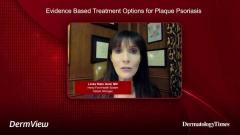
Roflumilast: Plaque Psoriasis Phase III Trial Overview
Jennifer Soung, MD, provides an overview of the phase III trials, DERMIS-1/DERMIS-2, in which roflumilast was used to treat plaque psoriasis
Episodes in this series

LindaStein Gold, MD: It’s interesting and that’s a great summary of why this drug works so well. A lot of people get confused. The PDE4 inhibitor works inside the cell, but not outside the cell like the biologic agents do. We know that this targets PDE4, which breaks down cyclic AMP [adenosine monophosphate] and helps to modulate that inflammatory environment within the cell. We know that by blocking that particular enzyme, we have a more anti-inflammatory environment and we see a downregulation of those particular cytokines that we know are associated with psoriasis, so we know that it works. We saw it, as you mentioned, orally and we’ve seen it topically in the clinical trials. These were interesting clinical trials and we have to remind people when we talk about phase 3 studies, that it’s the drug by itself. We’re not using anything else with it. Can you walk us through the phase 3 [DERMIS-1 and DERMIS-2] clinical trials with roflumilast?
Jennifer Soung, MD: In the study, there were 2 groups, the roflumilast active treatment group as well as the vehicle group, and the primary end point we looked at was investigator global assessment [IGA],…which meant almost clear with at least a 2-grade improvement at week 8. I want you to remember week 8 because certain topical studies look at their primary end point at different time points. One of the unique things about roflumilast is that they did their studies with a week 8 end point. Then we’re going to look at some other secondary end points such as age and a unique score that looks specifically at the IGA success of the intertriginous area. Can you tell us a little bit more about the IGA?
LindaStein Gold, MD: It’s interesting and as you mentioned, this was unique. We know that patients with psoriasis have the typical itchiness on the scalp, elbows, knees, and legs, but they can also have those skin folds. Sometimes it’s tricky because you look at it and you say that this vitiligo or is this psoriasis? If they have psoriasis elsewhere, that’s probably psoriasis. If you look at the periphery, you can see the typical scaling sometimes, but in the skin folds, it can look very different. Those are the tough patients because we can’t use a potent steroid there. We had some preliminary data in the past looking at the skin folds and sensitive areas with PDE4. With this one, they looked at specifically the intertriginous areas and found good success. They found that the majority of patients actually got almost clear, and of those, the majority got to completely clear, which was interesting.
Transcript edited for clarity
Newsletter
Like what you’re reading? Subscribe to Dermatology Times for weekly updates on therapies, innovations, and real-world practice tips.






















